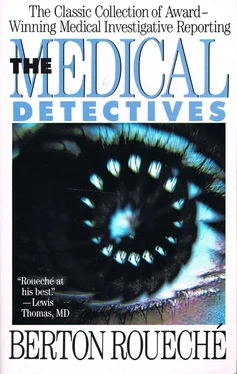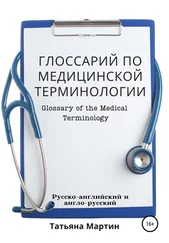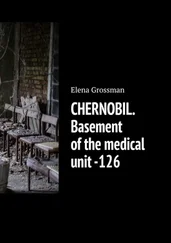Babesiosis came into prominence only four or five years ago, and most, if not all, known cases have been in and around coastal southern New England—the Cape Cod area, including Martha's Vineyard and the east end of Long Island. It's a serious disease. The Colorado doctor went on to say that he knew next to nothing about babesiosis, but if that was what John Hooper had, might it not also be the cause of Daniel Stafford's illness? If so, what should he do? That was a good question. There is a treatment for babesiosis—an agent called penamidine. But I wasn't about to recommend it in the case of Daniel Stafford. I didn't know about John Hooper up in Boston, but it didn't sound at all to me as if Daniel Stafford out in Grand Junction had babesiosis. Babesiosis is not a pneumonic disease. It tends to come on like malaria. Which is also, of course, a protozoan disease. I told the doctor what I thought. I thanked him for his call, his report. I said that his Martha's Vineyard houseparty sounded very much like something we would want to look into. I would keep him informed. And I was interested. I mean, all that pneumonia, all that pulmonary disease in one small group! 1 thought it sounded like a very unusual epidemic.
"I had a little problem there, of course. I wanted to go ahead, but I was working in the Parasitic Diseases Division and pulmonary disease was out of my official capacity. I was tempted to wonder if maybe I was mistaken about babesiosis. I didn't think so. . . and yet. Well, I decided to take at least the first step. I put in a call to Boston—to Beth Israel—and talked to one of the doctors there about John Hooper. Babesiosis was still very much on their minds, and Hooper was being treated for that. Their thinking was based on a blood smear that seemed to show a protozoan organism. He was not doing too well. He was still running a fever—up to a hundred and three. On the other hand, of course, they were keeping an open mind. They had taken blood samples for a series of evaluations. Then I called Martha's Vineyard and talked to the doctor there who was treating Patsy Lord Hooper. It was his impression, based on a chest X-ray, that she was suffering from an atypical viral pneumonia. She had run a fever up to a hundred and two, but she was now much improved. We talked about other possibilities—more specific kinds of infection—and he told me he was arranging for the indicated serum studies. I later learned that he had also treated Patsy's husband for a febrile illness—a mild case, from which he was now recovered. Patsy and her husband had spent the summer on the Vineyard at the family cottage. They were joined there on Wednesday, July 30, by the Staffords and John Hooper and by her father and a woman friend of his. The party broke up on Tuesday, August 5. Everybody had arrived well and remained well during the week of the gathering. But every one of them had become ill with pulmonary symptoms of some sort within a few days after the party. It was, indeed, an interesting epidemic.
"Well, I thought I'd made a start. In any event, I'd gone about as far as I could go on my own authority. And my superior was out of town. In an organization like C.D.C., everything is structured. Everything moves through channels. I put my notes together and got up and went down along the hall to what seemed to be the appropriate starting channel."
The immediate course and consequence of Dr. Teutsch's alerting report is noted in a subsequent interoffice memorandum channeled to Dr. William H. Foege, the director of the Center. It begins:
On August 16, 1978, Steven M. Teutsch, M.D., EIS Officer, Parasitic Diseases Division, Bureau of Epidemiology (BE), advised Arnold F. Kaufmann, D.V.M., Chief, Bacterial Zoonoses Branch, Bacterial Diseases Division; John Bennett, M.D., Director, Bacterial Diseases Division; William G. Winkler, D.V.M., Chief, Respiratory and Special Pathogens Branch (RSPB), Viral Diseases Division (VDD), BE; and Robert B. Craven, M.D., Chief, Respiratory Activity, RSPB, BE, of a possible outbreak of acute respiratory disease in humans on Martha's Vineyard, Massachusetts. Dr. Craven and Stanley I. Music, M.D., Deputy Director, Field Services Division, BE, contacted Joseph P. Rearden, M.D., Assistant State Epidemiologist, Massachusetts State Department of Public Health, and discussed this possible outbreak. . . .
Additional discussions were held with Edward W. Brink, M.D., EIS Officer, located at the Connecticut Department of Health, and Timm A. Edell, M.D., EIS Officer, Colorado Department of Health. Frequent discussions were held with the Massachusetts Department of Public Health staff over the next 12 days. . . .
On August 28, David R. Kimloch, M.D., Deputy Health Officer, Massachusetts Department of Public Health, spoke with Dr. Winkler and invited CDC to assist in the investigation. On August 29, Dr. Teutsch departed for Martha's Vineyard. . . .
"Actually," Dr. Teutsch says, "it wasn't quite as simple as that. The invitation from the Massachusetts Department of Public Health to C.D.C. to participate in the investigation was not entirely spontaneous. There was an eminence grise .
He was Infamous Dr. Alexander Langauir. Alex—everybody calls him Alex—was the founder of the Bureau of Epidemiology at C.D.C. and its first director. He's now retired, living in Boston, but it so happens that he has a summer cottage on Martha's Vineyard, and he was in it. He knew as well as anybody that state health departments do not automatically invite the participation of C.D.C. in local public-health investigations. They sometimes hesitate to appear to be in need of outside help. Which, of course, is only natural. Well, Alex had heard about the outbreak, and he knew that I had talked with the doctor who had treated Patsy Lord Hooper and her husband. He pulled some invisible strings and got himself appointed a temporary consultant to the local health department. Then he set about advising the local authorities to ask the state to ask C.D.C. to come in. And, as usual, Alex succeeded. And he was on hand to welcome me when I arrived on the Vineyard. I even stayed at his house.
"On the drive in from the airport, Alex and I brought each other up to date. There really wasn't much to report. Patsy Hooper had been discharged from the Vineyard hospital, and her brother-in-law John Hooper had been discharged from Beth Israel. But Dan Stafford, out in Colorado, had been flown from Grand Junction to a Denver hospital. He was in intensive care, on a respirator, and his condition was considered critical. That was an extra incentive to us to try to identify the problem. Dan Stafford couldn't be properly treated until his doctors knew the cause of his illness. And that was still a mystery. The first round of laboratory evaluations were inconclusive—more or less as expected. Pneumonia of the sort we were dealing with here is diagnosed by serum antibody tests, and antibodies don't appear in the blood during the acute stage of the illness. Antibodies rise slowly, as the body mobilizes its defenses, and an accurate positive result can't be expected in much less than three weeks. Arrangements were being made now for a new collection of blood samples—convalescent samples. The tests would be run at the C.D.C. laboratories in Atlanta. Another complication was the sheer number of disease possibilities to be evaluated. There are a good many atypical pneumonias. Legionnaire's disease was one possibility, and one that was very much on our minds in C.D.C. It is also very much an epidemic disease. Another possibility was mycoplasmal pneumonia. The other possibilities included psittacosis, influenza A-type and B-type, adenovirus infection, respiratory syncytial virus disease, tularemia, parainfluenza types 1, 2, and 3, and the three major fungal infections—histoplasmosis, blastomycosis, and coccidioidomycosis. Alex's first choice was Legionnaire's disease, and his second choice was mycoplasmal pneumonia. His third choice was a little scary. He thought it might be something brand-new—something we knew nothing about.
Читать дальше












